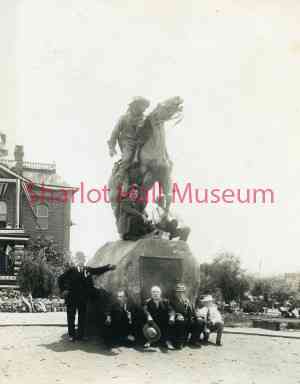by Drew Desmond
 As soon as news reached Prescott of William “Buckey” O’Neill’s death in Cuba during the Spanish-American War, one of his closest friends, MJ Hickey, was inspired to want a memorial to the late sheriff and mayor in his hometown. Hickey organized “a meeting of Prescott citizens [who] decided to incorporate the Captain O’Neill Volunteer Monument Association,” the Weekly Journal-Miner reported. They immediately began taking donations and recording pledges.
As soon as news reached Prescott of William “Buckey” O’Neill’s death in Cuba during the Spanish-American War, one of his closest friends, MJ Hickey, was inspired to want a memorial to the late sheriff and mayor in his hometown. Hickey organized “a meeting of Prescott citizens [who] decided to incorporate the Captain O’Neill Volunteer Monument Association,” the Weekly Journal-Miner reported. They immediately began taking donations and recording pledges.
Several novel methods of fundraising were employed. One farmer donated a gigantic pumpkin, which was auctioned off for the fund. A city councilman bought it for the price of nearly an average month’s wages and then put it back up for auction to continue funding the statue. According to Sharlot Hall, Joe Crane’s pumpkin “was sold again and again until it had brought many dollars into the fund.”
A hat manufacturer designed a “Buckey O’Neill Sombrero,” donating part of its profits to the cause. A local cigar-maker named his best cigar the “Buckey O’Neill” and gave all the profits from its sales to the fund. $100 was donated by selling 50,000 cigars. Even Teddy Roosevelt sent a personal check to the fund, although the amount was never disclosed. One particularly appreciated donation came from the Arizona Copper and Smelting Companies, who donated the matte copper necessary to produce the bronze. This donation not only spared a significant expense but guaranteed that most of the metal used to produce the statue would come from the Yavapai County hills. The leftover copper was sold to further fund the statue’s creation.
 Even with this donation, tens of thousands of dollars would still be needed to make the equestrian statue that Prescott desired. In 1899 a proposal to allocate $10,000 to the project was brought before the Territorial Legislature only to be defeated. The Maricopa County delegation wanted the memorial placed on the grounds of the capitol in Phoenix “where ten times the amount of people would be able to see it,” the Arizona Republican claimed. The Weekly Journal-Miner was bitter, complaining: “The defeat of the monument bill is due directly to the Maricopa delegation in the assembly.” Despite the defeat in the legislature, and perhaps because of it, the Yavapai County Board of Supervisors approved giving a portion of the courthouse plaza for the monument two months later.
Even with this donation, tens of thousands of dollars would still be needed to make the equestrian statue that Prescott desired. In 1899 a proposal to allocate $10,000 to the project was brought before the Territorial Legislature only to be defeated. The Maricopa County delegation wanted the memorial placed on the grounds of the capitol in Phoenix “where ten times the amount of people would be able to see it,” the Arizona Republican claimed. The Weekly Journal-Miner was bitter, complaining: “The defeat of the monument bill is due directly to the Maricopa delegation in the assembly.” Despite the defeat in the legislature, and perhaps because of it, the Yavapai County Board of Supervisors approved giving a portion of the courthouse plaza for the monument two months later.
.jpg) Momentum for the cause was strong until the Great Fire of July, 1900. It was difficult to get people to contribute to a fund for a monument on the plaza while the plaza was occupied by the tents of downtown businesses. Additionally, while the donated money had been safely deposited among several banks, the receipts and pledges burned in the fire.
Momentum for the cause was strong until the Great Fire of July, 1900. It was difficult to get people to contribute to a fund for a monument on the plaza while the plaza was occupied by the tents of downtown businesses. Additionally, while the donated money had been safely deposited among several banks, the receipts and pledges burned in the fire.
The 1901 and succeeding legislatures failed to pass funding until 1905, when a bill appropriating $10,000 for the monument to be located in Prescott was passed and signed by Governor Kibbey. However, the Maricopa delegation demanded three concessions. First, the $10,000 appropriation (about $340,000 today,) should be matched by private contributions (which never happened). Second, Governor Kibbey should appoint a commission with some representation from outside Yavapai County to oversee the project. Third, the statue should have a plaque stating the memorial was ultimately for all the brave Rough Riders of the 1st Volunteer Cavalry who perished.
Even then it was known that $10,000 would not be nearly enough. Such a complicated equestrian statue required both artistic and engineering genius. Getting the complicated design Prescott truly desired would take a miracle.
To be continued in two more articles.
“Days Past” is a collaborative project of the Sharlot Hall Museum and the Prescott Corral of Westerners International (www.prescottcorral.org). This and other Days Past articles are also available at www.archives.sharlothallmuseum.org/articles/days-past-articles/1 The public is encouraged to submit proposed articles and inquiries to dayspast@sharlothallmuseum.org Please contact SHM Research Center reference desk at 928-277-2003, or via email at archivesrequest@sharlothallmuseum.org for information or assistance with photo requests.


